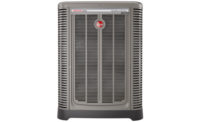ORLANDO, Fla. — Ducted air-source heat pumps remain a hot commodity with sales hitting a peak of almost 2.4 million units in 2014. The reason for their popularity, said John Remley, product manager at Nortek Global HVAC, is primarily a result of the volatility in the energy market. “Fluctuating gas prices have helped raise awareness of the benefits of dual-fuel systems. As a result, many markets that traditionally install an air conditioner with a gas furnace are seeing a growing demand for heat pumps with backup heat.”
In 2016, Remley expects local utility rebates to continue to drive heat pumps sales, with more rebates based on HSPF. “This is a trend that may affect future product designs and push sales towards modulating heat pumps,” Remley said.
AN ATTRACTIVE ALTERNATIVE
Johnson Controls Inc. highlighted its advanced 16-SEER heat pump, which will be launched in early 2016 in conjunction with an optimized 14-SEER series of heat pumps. “Heat pumps continue to gain traction in the market as an alternative to fossil fuel heating or electric resistance heating, noted Tom Goodnight, senior manager of residential product management, unitary products group, Johnson Controls.
These new systems feature reliable operation with robust compressor technology as well as reliable cold-weather operation that is ensured by a demand-defrost feature that maximizes heat pump performance by removing frost on the outdoor coil far more effectively than timer methods, said Goodnight. Long-lasting powdercoat paint provides a durable, automotive-quality finish, and durable steel coil guards provide protection against coil damage.
Johnson Controls applied lab-verified quality testing procedures to the new product line, including five years of accelerated field testing; extreme weather testing (from 140°F down to minus 10°); and salt spray testing to measure material corrosion, performance, and durability. “The new LX Series design is the outcome of 125,000 hours of research and testing and Johnson Controls’ world-class manufacturing and quality standards,” said Goodnight.
Bosch Thermotechnology Corp. introduced its inverter air-to-air ducted split-system heat pump, which achieves an 18-SEER efficiency rating. This new system can save homeowners hundreds of dollars a year on energy bills, said Kyle Murray, director of marketing, Bosch, by varying operating speeds depending on cooling and heating load rather than simply turning the unit on and off.
“By employing inverter technology, this new air-to-air heat pump accomplishes its high rating by varying operating speeds depending on cooling and heating load rather than simply turning the unit on and off,” said Murray. “In addition, both the indoor and outdoor units are much quieter than traditional models, thanks to an insulated compressor compartment and its silent blade technology.”
Yanmar highlighted its gas heat pump (GHP) system, which is new to the North American commercial market but has been available in the Japanese market for several years. Starting in June 2016, 8-, 10-, 12-, and 14-ton sizes will be available with a 14-ton heat recovery model, as well. The 8- to 14-ton outdoor units feature a dual scroll compressor design that enables optimal performance at varying engine rpms; if one compressor should fail, the other compressor can continue to produce heating and cooling until repairs can be made.
Yanmar Energy Systems has more than 260,000 gas engines in operation worldwide, said Chris Dockery, sales application engineer, Yanmar America. “The GHP operates on single-phase power, which reduces overall operating costs.”
The GHP is well-suited for education and health care facilities, restaurants, hotels, office buildings, multifamily housing, or any commercial facility that is looking to reduce the overhead of its facilities. “Consumers want to save on electrical usage as electrical prices continue to climb to record high prices in the U.S.,” said Dockery. “As demand for power increases, there are also fears of shortages during peak usage and regulations that penalize high energy usage. The GHP is the right solution for architects, engineers, and end users who are looking for a product to make buildings greener and more energy efficient.”
“In looking at the worldwide heat pump market, we see the movement to lower-GWP refrigerants,” said John Miles, Sanden Intl. (USA). “This can include the use of CO2 in a quest for higher performance and higher efficiency. Although this trend is slow in North America, it is going to be the next area of heat pump development.”
That trend is evident in Sanden’s SANCO2 heat pump water heater (HPWH), which uses R-744, or CO2, as the refrigerant. This natural refrigerant has a GWP of 1, compared to a GWP of more than 2,000 for R-410A. The system consists of an outdoor heat pump unit with a CO2 refrigerant-to-water heat exchanger, which produces water at approximately 150°. This water is stored in a separate indoor tank and mixed with cold water for domestic hot water use in the home. The split-system design increases the unit’s capacity for greater performance and faster recovery using just the heat pump system while the inverter compressor and a dc fan motor grant this unit exceptional efficiency.
Publication date: 2/22/2016
Want more HVAC industry news and information? Join The NEWS on Facebook, Twitter, and LinkedIn today!















